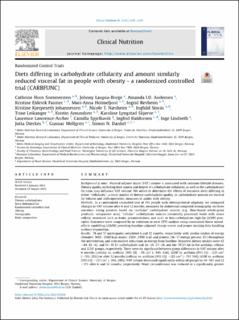Diets differing in carbohydrate cellularity and amount similarly reduced visceral fat in people with obesity - a randomized controlled trial (CARBFUNC)
Sommersten, Cathrine Horn; Laupsa-Borge, Johnny; Andersen, Amanda Iselin Olesen; Fasmer, Kristine Eldevik; Holmefjord, Mari-Anna Frydenlund; Revheim, Ingrid; Johannessen, Kristine Kjerpeseth; Næsheim, Nicole Tandrevold; Storås, Inghild; Leikanger, Trine; Amundsen, Kristin; Skjerve, Karoline Lyngstad; Lawrence-Archer, Laurence; Spjelkavik, Camilla; Haldorsen, Ingfrid S.; Lindseth, Inge Andreas; Dierkes, Jutta; Mellgren, Gunnar; Dankel, Simon N
Journal article, Peer reviewed
Published version

Åpne
Permanent lenke
https://hdl.handle.net/11250/3028850Utgivelsesdato
2022Metadata
Vis full innførselSamlinger
- Department of Clinical Science [2318]
- Registrations from Cristin [9791]
Sammendrag
Background & aims: Visceral adipose tissue (VAT) volume is associated with common lifestyle diseases. Dietary quality, including food matrix and degree of carbohydrate cellularity, as well as the carbohydrate/fat ratio, may influence VAT volume. We aimed to determine the effects of isocaloric diets differing in either “cellularity”, a novel marker of dietary carbohydrate quality, or carbohydrate amount on visceral fat volume and anthropometric measures in adults with obesity.
Methods: In a randomized controlled trial of 193 people with obesity/central adiposity, we compared changes in VAT volume after 6 and 12 months, measured by abdominal computed tomography, on three isocaloric eating patterns based on “acellular” carbohydrate sources (e.g., flour-based whole-grain products; comparator arm), “cellular” carbohydrate sources (minimally processed foods with intact cellular structures such as fruits, potatoes/tubers, and rice), or low-carbohydrate high-fat (LCHF) principles. Outcomes were compared by an intention-to-treat (ITT) analysis using constrained linear mixed-effects modelling (cLMM) providing baseline-adjusted change scores and proper missing data handling without imputation.
Results: 78 and 57 participants completed 6 and 12 months, respectively, with similar intakes of energy (females: 1820−2060 kcal, males: 2480−2550 kcal) and protein (16–17 energy percent, E%) throughout the intervention, and only modest reductions in energy from baseline. Reported dietary intakes were 42–44, 41–42, and 11–15 E% carbohydrate and 36–38, 37–38, and 66–70 E% fat in the acellular, cellular and LCHF groups, respectively. There were no significant between-group differences in VAT volume after 6 months (cellular vs. acellular [95% CI]: −55 cm³ [−545, 436]; LCHF vs. acellular [95% CI]: −225 cm³ [−703, 253]) or after 12 months (cellular vs. acellular [95% CI]: −122 cm³ [−757, 514]; LCHF vs. acellular [95% CI]: −317 cm³ [−943, 309]). VAT volume decreased significantly within all groups by 14–18% and 12–17% after 6 and 12 months, respectively. Waist circumference was reduced to a significantly greater degree in the LCHF vs. acellular group at 6 months (LCHF vs. acellular [95% CI]: −2.78 cm [−5.54, −0.017]).
Conclusions: Despite modest energy restriction, the three isocaloric eating patterns, differing in carbohydrate cellularity and amount, decreased visceral fat volume significantly and to a similar clinically relevant degree.
